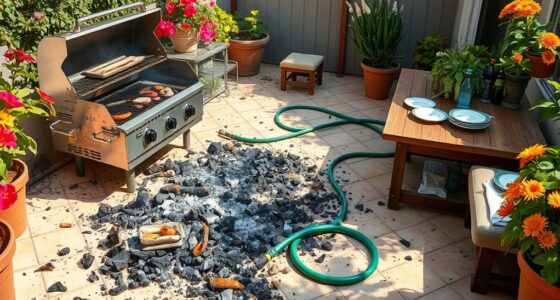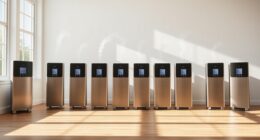During winter, you should focus on maintaining good indoor air quality by regularly cleaning and replacing your air purifier filters, as well as ensuring proper ventilation by opening windows briefly each day. Keep humidity levels below 50% to prevent mold growth, and use dehumidifiers if needed. Simple steps like cleaning surfaces and controlling moisture will help you breathe easier. To get detailed tips and strategies, continue exploring how to keep your indoor air fresh all season.
Key Takeaways
- Regularly replace or clean air purifier filters to maintain optimal air filtration during winter months.
- Keep indoor humidity below 50% using dehumidifiers to prevent mold growth and improve air quality.
- Ventilate indoor spaces daily by opening windows briefly to exchange stale indoor air with fresh outdoor air.
- Clean surfaces and use mold-inhibiting solutions to reduce mold spores and allergens indoors.
- Maintain heating and ventilation systems to ensure proper airflow and control moisture levels in winter.

As winter settles in, indoor air quality can quickly decline due to increased indoor activities and reduced ventilation. When you’re spending more time inside, the air can become stale, filled with dust, pet dander, and other allergens that can affect your health. One effective way to combat this is by maintaining your air purifier properly. Regular air purifier maintenance ensures it functions efficiently, capturing pollutants before they circulate in your home. Change filters as recommended, typically every three to six months, and clean the unit’s exterior and pre-filters frequently. Doing so not only prolongs the lifespan of your device but also guarantees you’re breathing cleaner air. An efficient air purifier can considerably reduce airborne irritants, especially when windows stay closed and airflow is limited.
Beyond using an air purifier, mold prevention becomes critical during winter. Cold weather often leads to increased indoor humidity from activities like cooking, showering, or even drying clothes indoors. When moisture levels rise, mold spores can thrive on walls, ceilings, and hidden areas, releasing spores into the air that can trigger allergies and respiratory issues. To prevent mold growth, monitor your home’s humidity levels—aim to keep them below 50%. Use a dehumidifier if necessary, especially in bathrooms and basements. Ensure proper ventilation in high-moisture zones by running exhaust fans or opening windows briefly to allow fresh air in. Fix leaks promptly and keep an eye out for signs of mold, such as musty odors or discoloration. Regular cleaning with mold-inhibiting solutions can also help reduce spores and prevent their spread.
During winter, it’s tempting to keep windows shut tight, but don’t forget that fresh air exchange is essential for good indoor air quality. Simple habits like opening a window for a few minutes daily can considerably reduce indoor pollutants and replenish oxygen levels. Additionally, maintaining your heating system and ensuring proper insulation can help control humidity and prevent condensation, which contributes to mold growth. Combining these steps with diligent air purifier maintenance and mold prevention strategies creates a healthier indoor environment. Not only does this minimize allergy symptoms and respiratory discomfort, but it also promotes overall well-being during the colder months. Staying proactive about indoor air quality in winter allows you to breathe easier, even when you’re bundled up inside, and keeps your home safe from mold and airborne pollutants.
Frequently Asked Questions
How Often Should Indoor Air Filters Be Replaced During Winter?
You should replace your air filter every 1 to 3 months during winter, depending on its lifespan and your home’s needs. Regular seasonal maintenance guarantees the best indoor air quality and prevents system strain. Check your filter monthly, especially if you have pets or allergies, and replace it promptly when it appears dirty or clogged. Doing so keeps your heating system efficient and maintains healthier indoor air throughout the colder months.
Can Winter Humidity Levels Affect Indoor Air Quality?
Did you know that humidity levels between 30-50% can substantially improve indoor air quality? Winter humidity fluctuations can impact your home’s air quality by promoting mold growth or increasing dust. Proper humidity control helps maintain ideal air circulation, reducing allergens and pollutants. If humidity drops too low, consider using a humidifier; if it’s too high, ventilate properly to keep your indoor environment healthy and comfortable.
Are There Specific Cleaning Methods for Winter Indoor Air Pollutants?
Yes, during winter, you should focus on pollutant removal techniques that target airborne allergens like dust and mold spores. Use HEPA filters and high-efficiency vacuum cleaners to effectively trap these particles. Regularly clean HVAC filters, vents, and humidifiers to prevent buildup. Also, consider using air purifiers with activated carbon filters to remove odors and airborne pollutants, ensuring your indoor air stays fresh and healthy throughout the colder months.
Do Indoor Plants Help Improve Air Quality in Winter?
Indoor plants are nature’s air purifiers, helping improve air quality in winter by filtering pollutants and increasing humidity. They act like green lungs, freshening your space naturally. To maximize their benefits, you need regular plant maintenance—watering, cleaning leaves, and pruning. While they can’t replace air purification systems, they do add a touch of life and help reduce indoor pollutants, making your home healthier during the colder months.
How Can I Reduce Mold Growth Indoors During Cold Months?
To reduce mold growth indoors during cold months, you should focus on mold prevention by controlling humidity levels and fixing leaks promptly. Improve indoor ventilation by regularly opening windows or using exhaust fans, especially in high-moisture areas like bathrooms and kitchens. Keep indoor spaces dry and well-ventilated, and consider using dehumidifiers if needed. Staying proactive with these steps helps keep mold at bay and maintains better air quality during winter.
Conclusion
As winter settles in, maintaining clean indoor air becomes essential for your health. Imagine you’re battling dry, stuffy air during the cold months—adding a humidifier and regular cleaning can make a huge difference. For example, Sarah improved her home’s air quality by sealing drafts and using an air purifier, noticing fewer colds and better sleep. Staying proactive with indoor air cleaning keeps your space healthier and more comfortable all winter long.










